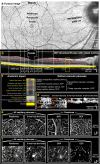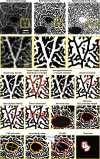Towards standardizing retinal optical coherence tomography angiography: a review
- PMID: 35304441
- PMCID: PMC8933532
- DOI: 10.1038/s41377-022-00740-9
Towards standardizing retinal optical coherence tomography angiography: a review
Abstract
The visualization and assessment of retinal microvasculature are important in the study, diagnosis, monitoring, and guidance of treatment of ocular and systemic diseases. With the introduction of optical coherence tomography angiography (OCTA), it has become possible to visualize the retinal microvasculature volumetrically and without a contrast agent. Many lab-based and commercial clinical instruments, imaging protocols and data analysis methods and metrics, have been applied, often inconsistently, resulting in a confusing picture that represents a major barrier to progress in applying OCTA to reduce the burden of disease. Open data and software sharing, and cross-comparison and pooling of data from different studies are rare. These inabilities have impeded building the large databases of annotated OCTA images of healthy and diseased retinas that are necessary to study and define characteristics of specific conditions. This paper addresses the steps needed to standardize OCTA imaging of the human retina to address these limitations. Through review of the OCTA literature, we identify issues and inconsistencies and propose minimum standards for imaging protocols, data analysis methods, metrics, reporting of findings, and clinical practice and, where this is not possible, we identify areas that require further investigation. We hope that this paper will encourage the unification of imaging protocols in OCTA, promote transparency in the process of data collection, analysis, and reporting, and facilitate increasing the impact of OCTA on retinal healthcare delivery and life science investigations.
© 2022. The Author(s).
Conflict of interest statement
The authors declare no competing interests. Figures are reproduced with publisher and author permissions.
Figures








Similar articles
-
Towards standardising retinal OCT angiography image analysis with open-source toolbox OCTAVA.Sci Rep. 2024 Mar 12;14(1):5979. doi: 10.1038/s41598-024-53501-6. Sci Rep. 2024. PMID: 38472220 Free PMC article.
-
Retinal applications of swept source optical coherence tomography (OCT) and optical coherence tomography angiography (OCTA).Prog Retin Eye Res. 2021 Sep;84:100951. doi: 10.1016/j.preteyeres.2021.100951. Epub 2021 Jan 28. Prog Retin Eye Res. 2021. PMID: 33516833 Review.
-
Select Features of Diabetic Retinopathy on Swept-Source Optical Coherence Tomographic Angiography Compared With Fluorescein Angiography and Normal Eyes.JAMA Ophthalmol. 2016 Jun 1;134(6):644-50. doi: 10.1001/jamaophthalmol.2016.0600. JAMA Ophthalmol. 2016. PMID: 27055248 Free PMC article.
-
Optical coherence tomography angiography: A comprehensive review of current methods and clinical applications.Prog Retin Eye Res. 2017 Sep;60:66-100. doi: 10.1016/j.preteyeres.2017.07.002. Epub 2017 Jul 29. Prog Retin Eye Res. 2017. PMID: 28760677 Free PMC article. Review.
-
Association Between the Severity of Diabetic Retinopathy and Optical Coherence Tomography Angiography Metrics.Front Endocrinol (Lausanne). 2021 Dec 10;12:777552. doi: 10.3389/fendo.2021.777552. eCollection 2021. Front Endocrinol (Lausanne). 2021. PMID: 34956088 Free PMC article.
Cited by
-
Peripapillary hyperreflective ovoid mass-like structures: Multimodal imaging-A review.Clin Exp Ophthalmol. 2023 Jan;51(1):67-80. doi: 10.1111/ceo.14182. Epub 2022 Nov 6. Clin Exp Ophthalmol. 2023. PMID: 36300762 Free PMC article. Review.
-
In Vivo Imaging of Retinal and Choroidal Morphology and Vascular Plexuses of Vertebrates Using Swept-Source Optical Coherence Tomography.Transl Vis Sci Technol. 2022 Aug 1;11(8):11. doi: 10.1167/tvst.11.8.11. Transl Vis Sci Technol. 2022. PMID: 35972433 Free PMC article.
-
Comparison of macular thickness in diabetic patients acquired from optical coherence tomography mode and optical coherence tomography angiography mode in Cirrus HD-OCT 5000.J Optom. 2024 Oct-Dec;17(4):100519. doi: 10.1016/j.optom.2024.100519. Epub 2024 Sep 6. J Optom. 2024. PMID: 39243491 Free PMC article.
-
Compact Linear Flow Phantom Model for Retinal Blood-Flow Evaluation.Diagnostics (Basel). 2024 Jul 26;14(15):1615. doi: 10.3390/diagnostics14151615. Diagnostics (Basel). 2024. PMID: 39125491 Free PMC article.
-
Optical coherence tomography angiography enables visualization of microvascular patterns in chronic venous insufficiency.iScience. 2024 Sep 20;27(11):110998. doi: 10.1016/j.isci.2024.110998. eCollection 2024 Nov 15. iScience. 2024. PMID: 39759076 Free PMC article.
References
-
- Wang DP, Xia J. Optics based biomedical imaging: principles and applications. J. Appl. Phys. 2019;125:191101.
-
- Wells WA, et al. Validation of novel optical imaging technologies: the pathologists’ view. J. Biomed. Opt. 2007;12:051801. - PubMed
-
- Tearney GJ, et al. Consensus standards for acquisition, measurement, and reporting of intravascular optical coherence tomography studies: a report from the international working group for intravascular optical coherence tomography standardization and validation. J. Am. Coll. Cardiol. 2012;59:1058–1072. - PubMed
-
- Munk MR, et al. Standardization of OCT angiography nomenclature in retinal vascular diseases: first survey results. Ophthalmol. Retin. 2021;5:981–990. - PubMed
Publication types
LinkOut - more resources
Full Text Sources
Miscellaneous

